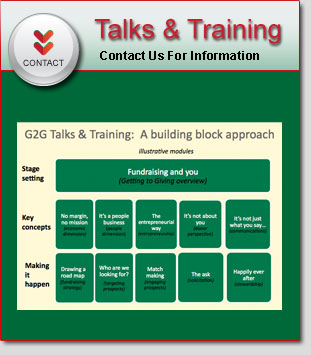The short answer: It all starts when you bring someone onto your board; she needs to understand that fundraising is part of the job. Next, make it easy and – dare I say it?! – fun for her!
It is fairly standard procedure to have a description of board members’ fundraising roles somewhere in the orientation packet. That’s good. My problem is that all too often it reads like a rental lease; it’s all about landlord’s rights and tenant’s responsibilities. There’s no reciprocity. Most people are afraid of asking for money, so you have to give them the support they need to feel they have a reasonable chance of success.
What kind of help is most useful?
First, help your board members understand the economic model of the organization. What role does philanthropic giving play in it? Large or small, they need to understand why it’s important to achieving your mission. Next, explain the fundraising process to them, make it less of a black box and help them see where they fit and how development staff will work them. Find a role for them that is a comfortable one for them. I have a friend who loves doing telethons; I’d be willing to pay to get out of doing it. I have another who flinches at the thought of asking someone for a donation, but graciously opens her home for fundraising events.
When it comes to soliciting a significant gift, one of the most important things you can do is to help people understand what points they need to make in communicating with a potential donor. That involves both parts of the transaction: the give and the get. Don’t assume your board member knows everything about the person he is being asked to solicit. Do your homework, and give him clues about what might be of interest to that particular individual and why. Then give him a good pitch to make. A fancy brochure won’t do it, and a formal case statement tends to be too internally oriented. You need to arm him with compelling reasons why his prospect should want to give to you and your cause.
Fundraising is part of every board member’s job, whether she is on the development committee or not. When writing Getting to Giving, we thought that fact so important – and so often misunderstood – that we devoted our last chapter to what it means to be a fundraising leader. Here’s a checklist of sorts for fundraising leadership roles:
- Create a shared vision for success
- Accept responsibility for financial health of the organization
- Ensure that fundraising plans are ambitious but realistic
- Take the competitive landscape into account
- Build competencies on every dimension
- Ensure that fundraising plans are well executed
- Ensure that resources are available to everyone
- Remove impediments to performance
- Set ethical standards and norms
On a more personal level, I also shared a few things about what I’ve learned about being effective and comfortable in the role of a fundraising leader. Here are my top five things to remember:
- It’s not about you
- Everyone’s a fundraiser
- You’re the model
- To be a good leader, listen
- It should be fun!
There is a lot out there on the subject of nonprofit boards in general, and their fundraising roles in particular. Here’s a link to the results of a quick online search that we did; a sampling of information sources and a few interesting tidbits.



